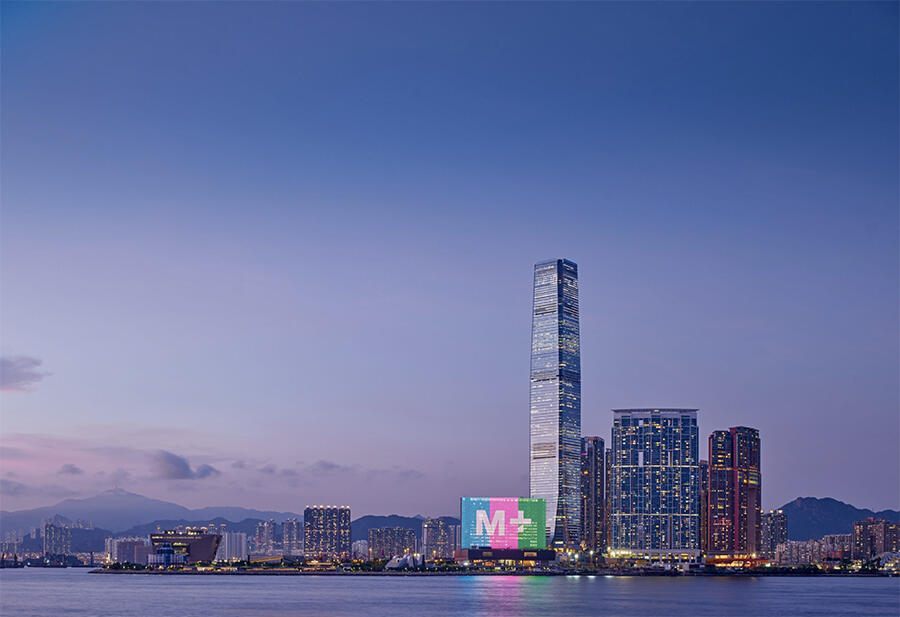Does Hong Kong’s M+ Live up to Its Promise?
Ophelia Lai pays a visit to the feted new museum – a controversial government-backed, multibillion-dollar institution built to rival Tate Modern
Ophelia Lai pays a visit to the feted new museum – a controversial government-backed, multibillion-dollar institution built to rival Tate Modern

I first visited M+ museum – the feted new addition to Hong Kong’s cultural landscape – on a Sunday morning fit for an advertisement. The scene was almost a replica of a photo circulated months before in a press release – sunshine, pristine surroundings, children whizzing past on bikes – albeit with the addition of enthusiastic, mid-morning crowds.
Inside, the white spiral staircase on which visitors jostled for selfies is the exact spot where, days earlier, at the museum’s officiation, Henry Tang, chairman of the West Kowloon Cultural District Authority (WKCDA), asserted that M+ will ‘uphold and encourage freedom of artistic expression and creativity’. But, at the same time, it must ‘ensure that all the exhibitions will comply with the laws’. His words exemplify the increasingly casuistic official discourse surrounding the museum’s values.

M+ executive director Suhanya Raffel has consistently defended the institution’s curatorial independence. However, considering M+ is owned by the WKCDA, the idea that it can operate freely in this time of tightening political control warrants scepticism. Yet, it is in this light that the opening programme, particularly the sprawling chronological survey of Chinese contemporary art from the museum’s foundational Sigg Collection, is all the more impressive for its boldness. ‘From Revolution to Globalisation’ – overseen by M+ senior curator Pi Li – presents a clear trajectory of the artistic movements of the past four decades within an evolving China and reflects the museum’s ambitions to become a leading authority on Chinese contemporary art history. The inclusion of Wang Xingwei’s New Beijing (2001) supports Raffel’s assurance that M+ will display politically sensitive artworks. The painting parodies photojournalist Liu Heung Shing’s image of two injured students, lying prone on a bicycle flatbed, being rushed from the Tiananmen Square protests on 4 June 1989. In an absurd twist, Wang replaces the bloodied figures with penguins. The work carries a fresh sting in the wake of Hong Kong’s crackdown on the Tiananmen commemorations, which the government has banned for a second year running.
M+’s ability to situate its displays within broader trans-regional narratives elevates it from a robust local institution to a global one. In the South Galleries, ‘Individuals, Networks, Expressions’ spins a complex web of connections across artworks from different geographies and movements in the past half-century. The exhibition is occasionally thin, with important postwar currents represented by limited selections. However, unexpected and compelling pairings – such as Cai Guo-Qiang’s Gunpowder Drawing No. 8-A5 (1988) with Pacita Abad’s I Have One Million Things to Say (2002) – redeem the show. In the Courtyard Galleries, ‘The Dream of the Museum’ – helmed by chief curator Doryun Chong – accessibly unpacks inquiries into authorship, authenticity and museological display in conceptual works by artists such as Marcel Duchamp and Danh Vo.

M+’s self-proclaimed global positioning is not free from detractors, with some questioning the museum’s connectedness to the local community. Given the mounting economic and political pressures threatening artists and independent spaces in Hong Kong – agile responders to the turmoil of the past two years – it’s easy to see why a government-backed, multibillion-dollar museum built to rival Tate Modern may appear out of touch.
Yet, it seems insular to undervalue M+’s critical engagement with local culture, demonstrated best in ‘Hong Kong: Here and Beyond’, an exhibition tracing the city’s changing identity from the 1960s onwards. A highlight was Freeman Lau’s pair of posters, titled The Changing Era (1997), one of which features an image of Mao Zedong under the text ‘Finally Returned’, the other the words ‘Should Return’ over a portrait of Queen Elizabeth II. Nested within each composition is a smaller image of the opposing figurehead, resulting in an ambiguous formulation that evinces the former British colony’s identity crisis during the 1997 handover. Yet, Lau’s work feels just as relevant today amid another exodus of people from Hong Kong to the UK.

What distinguishes the show is its examination of not only how Hong Kong sees itself but also how it is seen by others. Tiffany Chung’s installation flotsam and jetsam (2015–16), about the marginalized experiences of Vietnamese refugees in Hong Kong following the Vietnam War, is a crucial addition in this regard. ‘Hong Kong: Here and Beyond’ underlines M+’s ability to mediate different positionalities and perspectives, meaningfully elucidating the city’s multifaceted history.
Rigorously engaging with diverse narratives within and about Asia, the institution’s opening programme aligns with its stated ambition to serve as a bustling local attraction with the potential to exert real influence in the cultural landscape of the wider region. But the museum’s credibility as an authoritative voice on Asia’s visual culture will be undermined if it is seen as vulnerable to censorship. M+ has much to say. It would be a shame for its incisive work to be shadowed by repressive – and regressive – politics.
Main image: M+, Hong Kong, 2021. Courtesy: Herzog & de Meuron; photograph: © Kevin Mak






















